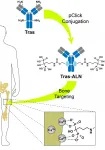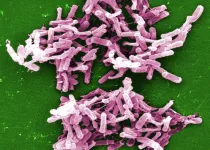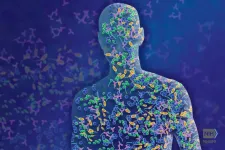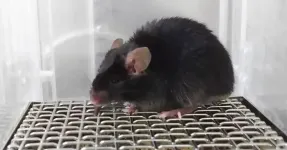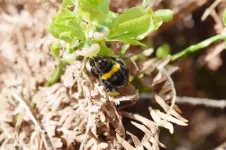(Press-News.org) SAN FRANCISCO, CA--June 23, 2021--A healthy heart is a pliable, ever-moving organ. But under stress--from injury, cardiovascular disease, or aging--the heart thickens and stiffens in a process known as fibrosis, which involves diffuse scar-like tissue. Slowing or stopping fibrosis to treat and prevent heart failure has long been a goal of cardiologists.
Now, researchers at Gladstone Institutes have discovered a master switch for fibrosis in the heart. When the heart is under stress, they found, the gene MEOX1 is turned on in cells called fibroblasts, spurring fibrosis. Their new study, published in the journal Nature, suggests that blocking this gene could prevent fibrosis in the heart--and other organs that can similarly fail from stiffening over time.
"With these findings, we may have an entirely new way to stop that slow but steady progression of heart failure that affects 24 million people worldwide," says Deepak Srivastava, MD, president and senior investigator at Gladstone and senior author of the study. "Right now, we don't have any drugs that effectively prevent fibrosis."
Fibroblasts are key to normal organ repair and integrity; they're the most abundant cell in connective tissue and congregate at sites of bodily damage or disease. In many cases, their presence is beneficial. They help launch immune responses, mediate inflammation, and rebuild tissue. But in chronic disease, activated fibroblasts can continuously create scar tissue, impeding normal organ function.
Researchers knew that in mice with heart disease, blocking a class of proteins known as BET proteins slowed fibrosis and improved heart function, although it wasn't clear which cell type in the heart was being affected. They also knew that BET proteins are needed throughout the body for many important functions, including normal immunity.
"To treat a heart failure patient with a BET inhibitor is a sledgehammer approach, because we might prevent fibrosis, but we'd likely also disrupt many other critical cellular functions throughout the body in the process," says Srivastava, who is also a pediatric cardiologist and a professor in the Department of Pediatrics at UC San Francisco (UCSF). "Our hope was that if we could understand the precise mechanism through which BET works in the heart, we could home in on a narrower target with fewer side effects."
Srivastava's group studied mice who developed heart failure, and treated them daily with a BET inhibitor for 1 month. The researchers used single-cell RNA sequencing and single-cell epigenomics--which can reveal which genes in a cell are accessible and being turned on at any given time--to compare heart cells from mice before, during, and after the treatment, and correlate those results with heart function.
These technologies allowed the researchers to analyze thousands of cells at once, and separate them based on their specific cell type. Thanks to a close collaboration with the laboratory of Katie Pollard, PhD, at Gladstone, they developed new computational methods to learn from the vast amount of data generated by their analysis.
While the scientists didn't find significant changes to heart muscle cells, they observed that the treatment induced striking changes in cardiac fibroblasts, which represent more than half the cells in the human heart.
In particular, the researchers discovered that the gene MEOX1 was highly active in the mice with heart failure and that its levels dramatically dropped when the mice were treated with the BET inhibitor. Moreover, the levels of MEOX1 correlated with activation of the fibroblasts; when the gene was switched on, the fibroblasts were better at making scar tissue. In fact, MEOX1 seemed to be a "master regulator" of fibroblast activation, controlling thousands of other genes that contribute to fibrosis.
"MEOX1 is a gene known to be important in early development, but not much was known about it in adult disease, so our findings were quite surprising," says Michael Alexanian, PhD, a Gladstone postdoctoral scholar and first author of the new study.
The findings point to the precise part of the DNA, regulated by BET, that is responsible for MEOX1 to be turned on in disease states. Using CRISPR genome-editing technology, the scientists showed that deleting this small part of the DNA prevented MEOX1 from being activated, even under stress.
The team went on to show that blocking MEOX1 from being switched on had the same effects as a BET inhibitor--it blocks the activation of fibroblasts. The researchers also studied other organs that commonly become fibrotic with disease, and found that cellular stress led to higher levels of MEOX1 in human lung, liver, and kidney fibroblasts.
"Fibrosis is much broader than just the heart; it affects many other organs," says Srivastava. "We hope this discovery provides an avenue to slow down or stop fibrosis in many settings."
More studies are needed to show whether blocking MEOX1 could have therapeutic value in humans. Srivastava and his colleagues are now conducting additional studies to better understand the long-term role of MEOX1 in heart disease and heart failure.
"In a coordinated effort to design novel therapies for heart failure, researchers are looking for molecular clues to use as therapeutic targets," says Bishow Adhikari, PhD, a program officer in the heart failure and arrhythmias branch, located within the Division of Cardiovascular Sciences at the National Heart, Lung, and Blood Institute. "These findings are highly informative and bring researchers closer to advancing new therapeutic strategies to better predict and treat heart disease."
INFORMATION:
About the Study
The paper "A Transcriptional Switch Governs Fibroblast Activation in Heart Disease" was published by the journal Nature on June 23, 2021: https://www.nature.com/articles/s41586-021-03674-1.
Other authors are: Pawel Przytycki, Arun Padmanabhan, Lin Ye, Bárbara Gonzàlez Teràn, Ana Catarina Silva, Qiming Duan, Sanjeev Ranade, Franco Felix, Clara Yougna Lee, Nandhini Sadagopan, Angelo Pelonero, Yu Huang, Casey Gifford, and Saptarsi Haldar of Gladstone; Rudi Micheletti and Michael Rosenfeld of UC San Diego; Joshua Travers and Timothy McKinsey of University of Colorado; Ricardo Linares-Saldana, Li Li and Rajan Jain of University of Pennsylvania; and Gaia Andreoletti of UCSF.
The work at Gladstone was supported by the Swiss National Science Foundation, the National Institutes of Health (P01 HL098707, HL098179, R01 HL127240, P01 HL146366, R01 HL057181, R01 HL015100, C06 RR018928), the San Simeon Fund, the Tobacco?Related Disease Research Program, A.P. Giannini Foundation, Michael Antonov Charitable Foundation Inc., Sarnoff Cardiovascular Research Foundation, the American Heart Association, the Roddenberry Foundation, the L.K. Whittier Foundation, Dario and Irina Sattui, and the Younger Family Fund.
About Gladstone Institutes
To ensure our work does the greatest good, Gladstone Institutes (https//gladstone.org) focuses on conditions with profound medical, economic, and social impact--unsolved diseases. Gladstone is an independent, nonprofit life science research organization that uses visionary science and technology to overcome disease. It has an academic affiliation with the University of California, San Francisco.
HOUSTON - (June 23, 2021) - Bone cancer is hard to treat and prone to metastasis. Research teams at Rice University and Baylor College of Medicine have a new strategy to attack it.
Chemist Han Xiao at Rice and biologist Xiang Zhang at Baylor and their labs have developed an antibody conjugate called BonTarg that delivers drugs to bone tumors and inhibits metastasis.
Their open-access study, which appears in Science Advances, shows how Xiao's pClick technology can be used to link bone-targeting antibodies and therapeutic molecules.
In experiments, they used pClick to couple a molecule used to treat osteoporosis, alendronate, with the HER2-targeting antibody trastuzumab used to treat breast cancer and found it significantly enhanced the concentration ...
Most survivors of squamous cell head and neck cancers report that their sense of taste is dulled, changed or lost during radiation treatment, causing them to lose interest in eating and diminishing their quality of life.
In a study of taste and smell dysfunction with 40 cancer survivors, scientists at the University of Illinois Urbana-Champaign found that the tips of these individuals' tongues were significantly less sensitive to bitter, salty or sweet tastes than peers in the control group who had never been diagnosed with cancer.
In a paper published in the journal Chemical Senses, the U. of I. team said this diminished taste sensitivity suggested that the taste ...
In New England, constraints in the supply of natural gas have led to nearly a quarter of all unscheduled power plant outages. In a new study, researchers used data from power plant failures in the 2010s to develop a supply curve of the costs required for generators to mitigate fuel shortages in the region. The study found that storing both oil and gas on-site could reduce dependence by power plants on gas grids in geographic areas with few pipelines.
The study was conducted by researchers at Carnegie Mellon University (CMU), The Pennsylvania State University, and the North American Electric Reliability Corporation. It is published in The Electricity Journal.
"Gas ...
Toronto - Last winter, Goldman Sachs reported it was working to make things better after a group of junior analysts revolted against 100-hour work weeks.
That's a smart thing to do, suggests a new study from the University of Toronto's Rotman School of Management. Drawing from more than 6,000 employee reviews of their workplaces and data on their firms' forecasting accuracy, the research shows that making improvements to hardworking analysts' work-life balance produces dividends for the company and for the analysts' careers.
"There is a lot of anecdotal evidence, but here we provide large-scale evidence that supports the recent push to grant these employees at least some reprieve from the extremes of their jobs," said Ole-Kristian Hope, who is the Deloitte Professor of Accounting ...
The Gerontological Society of America's highly cited, peer-reviewed journals are continuing to publish scientific articles on COVID-19. The following were published between May 4 and June 14; all are free to access: Cardiometabolic therapy and mortality in very old patients with diabetes hospitalized due to COVID-19: Research article in The Journals of Gerontology, Series A: Biological Sciences and Medical Sciences by Jose Manuel Ramos-Rincón, MD, PhD, Luis M. Pérez-Belmonte, MD, PhD, Francisco Javier Carrasco-Sánchez, MD, PhD, Sergio Jansen-Chaparro, MD, PhD, Mercedes De-Sousa-Baena, MD, José Bueno-Fonseca, MD, ...
Best known for its presence in house cats and a tendency to infect and alter the behaviors of rodents and humans, the parasite Toxoplasma gondii (T. gondii) is also associated with bold behavior among wild hyena cubs and risk of death during interactions with lions, finds new research from the University of Colorado Boulder.
The findings, published this week in Nature Communications, reinforce previous research which has found the parasite can prompt profound behavioral changes in its hosts, and potentially in the 2 billion people worldwide estimated to be infected by it. While T. gondii has been well studied in laboratory settings with humans and wild-caught ...
Researchers from Charité - Universitätsmedizin Berlin and the University of California in San Francisco were able to show for the first time that a very low calorie diet significantly alters the composition of the microbiota present in the human gut. In a current Nature* publication, the researchers report that dieting results in an increase of specific bacteria - notably Clostridioides difficile, which is associated with antibiotic-induced diarrhea and colitis. These bacteria apparently affect the body's energy balance by exerting an influence on the absorption of nutrients ...
WHAT:
National Institutes of Health scientists and their collaborators have identified an internal communication network in mammals that may regulate tissue repair and inflammation, providing new insights on how diseases such as obesity and inflammatory skin disorders develop. The new research is published in Cell.
The billions of organisms living on body surfaces such as the skin of mammals--collectively called microbiota--communicate with each other and the host immune system in a sophisticated network. According to the study, viruses integrated in the host genome, remnants of previous infections called endogenous retroviruses, can ...
Researchers at the RIKEN Center for Brain Science and the RIKEN BioResource Research Center in Japan, along with collaborators at the State University of New York at Buffalo, have created a mouse model that allows the study of naturally occurring melatonin. Published in the Journal of Pineal Research, these first experiments using the new mice showed that natural melatonin was linked to a pre-hibernation state that allows mice to slow down their metabolism and survive when food is scarce, or temperatures are cold.
Melatonin is called "the hormone of darkness" because it's released by the brain in the dark, which usually means at night. It tells the body when it's dark outside so that the body can switch to 'night mode'. Although other hormones are easily studied in the laboratory, ...
How many tree species are there in the forest? How are the trees scattered throughout? How high are the individual tree crowns? Are there fallen trees or hollowed-out tree trunks? Forest scientists characterize forests according to structural factors. "Structural richness is very important for biodiversity in forests. But forests used for forestry are generally poor in terms of structure," says Tristan Eckerter from the Chair of Nature Conservation and Landscape Ecology at the University of Freiburg. Therefore, together with research teams from the Chair of Silviculture and the Black Forest National Park, he investigated ...

